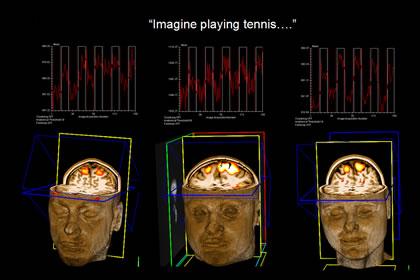Neuroscientists have reignited the debate over whether patients in a vegetative state are conscious of their surroundings, by claiming that a woman in such a 'waking coma' can respond to verbal commands. The researchers say that brain scans show that she can selectively think of performing certain actions, such as playing tennis, on request.
 Three healthy participants at the MRC Cognition and Brain Sciences Unit show increased activity in the motor areas of the brain when asked to imagine playing tennis. The activation observed in the vegetative patient was identical.Adrian Mark Owen
Three healthy participants at the MRC Cognition and Brain Sciences Unit show increased activity in the motor areas of the brain when asked to imagine playing tennis. The activation observed in the vegetative patient was identical.Adrian Mark OwenThe British-led research team made the discovery after examining the brain of a severely brain-damaged patient who had been in a vegetative state — defined as a lack of detectable consciousness — for five months. After years of studying the brains of vegetative patients, this is the first evidence, the researchers say, of awareness in such a patient, rather than simple automatic brain responses.
The patient, a 23-year-old woman who was severely injured in a car accident in July 2005, had shown no outward signs of awareness. She had retained normal patterns of sleep and open-eyed 'wakefulness', report Adrian Owen, of the Medical Research Council Cognition and Brain Sciences Unit in Cambridge, UK, and his colleagues — but her open eyes could not focus or follow someone around a room.
The team first compared scans of the patient's brain with those of 12 healthy volunteers in response to commands either to picture themselves playing a game of tennis or to imagine walking around their house. The two imagined activities produced markedly different patterns of brain activation when scanned using functional magnetic resonance imaging (fMRI), which highlights regions of brain activity.
When asked to imagine the different scenarios, the patient showed strikingly similar patterns of brain activation to those of the healthy volunteers, the researchers report in this week's Science1 (see picture). This shows that she can 'play tennis in her head', they argue, even though she shows no outward response to the request.
Aware?
The research throws open the question of what constitutes a vegetative state. "She does fulfil all the clinical criteria," says Owen. "What we have developed is a method for detecting when someone is aware in the absence of other clinical evidence."
Other experts are not convinced that the results genuinely show that the patient was responding to the commands, rather than having a more instinctive response. "You don't really know whether the patient is imagining a tennis game or simply responding to the word 'tennis'," comments Paul Matthews, a clinical neuroscientist at Imperial College, London. "There's a lot that's interesting about this research but I think their result is overclaimed."
"Our results could not be explained by an automatic response," Owen counters. "We have shown that the word 'tennis' produces a very transient response of just a few seconds. But the response in our study was long-lived, lasting around 30 seconds, and stopped when we told her to stop and rest."
Ethical issues
“What we've developed is a method for detecting when when someone is aware in the absence of other clinical evidence.”
Adrian Owen
MRC Cognition and Brain Sciences Unit, Cambridge
If vegetative people's brains do indeed respond to what is going on around them, the method opens up the exciting prospect of allowing these patients to communicate with the outside world. Asking the patient a series of yes/no questions, about her feelings and about facts such as her name, could help to clear up whether the response is truly conscious, as well as allowing a line of communication with her.
"It's obviously the next thing to do, but it's too early to say if it would work," says Owen. "We just don't know exactly what she's capable of."
What's more, so far they have only seen this effect in a single patient, Owen admits. His team is hoping to investigate more patients to try and replicate the results.
If other patients seem to have similar abilities, it raises the possibility that some vegetative patients have a "rich and complex internal life", suggests Narender Ramnani, a neuroscientist at Royal Holloway, University of London.
That raises troubling ethical questions, similar to those raised by the case of Terri Schiavo, a vegetative patient whose feeding tube was removed in March 2005. "Given that such patients might be conscious and capable of making their own decisions," Ramnani asks, "is it acceptable for others to terminate their lives without the consent of the patients?"
ADVERTISEMENT
Schiavo, however, was almost certainly much more severely injured than the patient in the latest study, Owen says. Schiavo was diagnosed as 'persistently vegetative', having shown no sign of recovery for years. For Owen's patient, who had suffered a head injury only five months previously, there is "something like a 20% chance of recovery", he says. There has been no change in her condition, however, since the research was carried out in late 2005.
Perhaps the ultimate problem for understanding the vegetative state is that it can be caused by widely varying brain injuries, meaning that every patient is different. Patients at the least severe end of the spectrum, such as the latest case, may indeed have some awareness of the world. "But we can't get inside her head and see what the quality of her experience is like," Owen admits.
Visit our ofwomaninwaking_co.html">newsblog to read and post comments about this story.
MRC Cognition and Brain Sciences Unit, Cambridge
